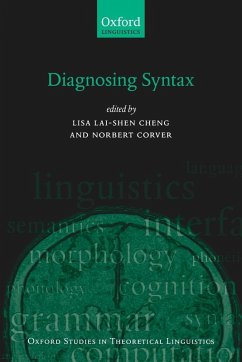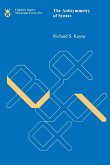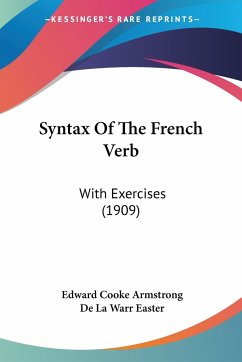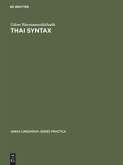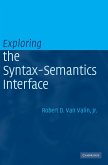Diagnosing Syntax
Herausgeber: Cheng, Lisa Lai-Shen; Corver, Norbert
Diagnosing Syntax
Herausgeber: Cheng, Lisa Lai-Shen; Corver, Norbert
- Broschiertes Buch
- Merkliste
- Auf die Merkliste
- Bewerten Bewerten
- Teilen
- Produkt teilen
- Produkterinnerung
- Produkterinnerung
Drawing on the expertise of over 20 leading scholars and their empirically rich data, this book presents current thoughts on, and practical answers to, the question: What are the diagnostic signs, techniques and procedures that can be used to analyse natural language syntax?
Andere Kunden interessierten sich auch für
![The Antisymmetry of Syntax The Antisymmetry of Syntax]() Richard S. KayneThe Antisymmetry of Syntax33,99 €
Richard S. KayneThe Antisymmetry of Syntax33,99 €![English Historical Syntax English Historical Syntax]() David DenisonEnglish Historical Syntax111,99 €
David DenisonEnglish Historical Syntax111,99 €![The clausal syntax of German Sign Language The clausal syntax of German Sign Language]() Fabian BrossThe clausal syntax of German Sign Language26,99 €
Fabian BrossThe clausal syntax of German Sign Language26,99 €![Syntax Of The French Verb Syntax Of The French Verb]() Edward Cooke ArmstrongSyntax Of The French Verb25,99 €
Edward Cooke ArmstrongSyntax Of The French Verb25,99 €![The Leading Questions On The Grammar Of The German Language (1884) The Leading Questions On The Grammar Of The German Language (1884)]() E. HeumannThe Leading Questions On The Grammar Of The German Language (1884)19,99 €
E. HeumannThe Leading Questions On The Grammar Of The German Language (1884)19,99 €![Thai Syntax Thai Syntax]() Udom WarotamasikkhaditThai Syntax78,99 €
Udom WarotamasikkhaditThai Syntax78,99 €![Exploring the Syntax-Semantics Interface Exploring the Syntax-Semantics Interface]() Robert D. Jr. van ValinExploring the Syntax-Semantics Interface114,99 €
Robert D. Jr. van ValinExploring the Syntax-Semantics Interface114,99 €-
-
-
Drawing on the expertise of over 20 leading scholars and their empirically rich data, this book presents current thoughts on, and practical answers to, the question: What are the diagnostic signs, techniques and procedures that can be used to analyse natural language syntax?
Produktdetails
- Produktdetails
- Verlag: Oxford University Press(UK)
- Seitenzahl: 618
- Erscheinungstermin: 25. Juli 2013
- Englisch
- Abmessung: 234mm x 156mm x 33mm
- Gewicht: 925g
- ISBN-13: 9780199602506
- ISBN-10: 0199602506
- Artikelnr.: 37329159
- Herstellerkennzeichnung
- Libri GmbH
- Europaallee 1
- 36244 Bad Hersfeld
- gpsr@libri.de
- Verlag: Oxford University Press(UK)
- Seitenzahl: 618
- Erscheinungstermin: 25. Juli 2013
- Englisch
- Abmessung: 234mm x 156mm x 33mm
- Gewicht: 925g
- ISBN-13: 9780199602506
- ISBN-10: 0199602506
- Artikelnr.: 37329159
- Herstellerkennzeichnung
- Libri GmbH
- Europaallee 1
- 36244 Bad Hersfeld
- gpsr@libri.de
Lisa Lai-Shen Cheng is Chair Professor of Linguistics at Leiden University. She received her PhD in Linguistics from MIT in 1991. Her main research interests include comparative syntax (both micro- and macro-comparation), syntax-semantics interface and syntax-phonology interface. Some recent research topics include verb doubling, free choice items and prosodic domains. She has published in Linguistic Inquiry, The Linguistic Review, Syntax, Journal of East Asian Linguistics, Journal of African Language and Linguistics, Natural Language Semantics, and Journal of Semantics. Norbert Corver is Professor of Dutch Linguistics at Utrecht University. He received his PhD in Linguistics from Tilburg University in 1990. His main research interests are Dutch syntax, micro- and macro-comparative syntax, the study of syntax at the interface with information structure and affect. Some recent research topics include predicate displacement, the internal syntax of adjective phrases, NP-ellipsis, the syntax of interjections, exclamatives and curse expressions. He has published in Natural Language and Linguistic Theory, Linguistic Inquiry, The Linguistic Review, Lingua, Linguistics, and The Journal of Comparative Germanic Linguistics.
* 1: Lisa Lai-Shen Cheng and Norbert Corver: Syntactic Diagnostics in
the Study of Human Language
* Part I: Head Movement
* 2: Christer Platzack: Head Movement as a Phonological Operation
* 3: Heidi Harley: Getting Morphemes in Order: affixation and head
movement
* 4: Naama Friedmann: Verb Movement to C: from agrammatic aphasias to
syntactic analysis
* 5: Jochen Zeller: In Defence of Head Movement: evidence from Bantu
* 6: Heidi Harley: Diagnosing Head Movement
* Part II: Phrasal Movement
* 7: David Pesetsky: Phrasal Movement and its DIscontents: diseases and
diagnoses
* 8: Winfried Lechner: Diagnosing Covert Movement: the Duke of York
reconstruction
* 9: Hamida Demirdache: Arguments for LD Movement in LD Questions in
Child Language
* 10: Maria Polinsky and Eric Potsdam: Diagnosing Covert A-movement
* 11: Winfried Lechner: Diagnosing XP Movement
* Part III: Agreement
* 12: Sandra Chung: The Syntactic Relations Behind Agreement
* 13: Ora Matushansky: Gender Confusion
* 14: Maria Teresa Guasti: Agreement in the Production of Subject and
Object wh-questions
* 15: Jamal Ouhalla: Agreement Unified: Arabic
* 16: Maria Teresa Guasti and Ora Matushansky: Diagnosing Agreement
* Part IV: Anaphora
* 17: Martin Everaert and Elena Anagnostopoulou: Identifying Anaphoric
Dependencies
* 18: Chris Tancredi: Condition B
* 19: Sergey Avrutin and Sergio Baauw: A Processing View on Agrammatism
* 20: Norvin Richards: Tagalog Anaphora
* 21: martin Everaert: Diagnosing Anaphora
* Part V: Ellipsis
* 22: Jason Merchant: Polarity Item Under Ellipsis
* 23: Susanne Winkler: Syntactic Diagnostics for Extraction of
Focus From Ellipsis Site
* 24: Lyn Frazier: A Recycling Approach to Processing Ellipsis
* 25: Jeroen van Craenenbroeck and Anikó Lipták: What Sluicing Can
do, What it Can't, and in Which Language: on the cross-linguistic
syntax of ellipsis
* 26: Jason Merchant: Diagnosing Ellipsis
the Study of Human Language
* Part I: Head Movement
* 2: Christer Platzack: Head Movement as a Phonological Operation
* 3: Heidi Harley: Getting Morphemes in Order: affixation and head
movement
* 4: Naama Friedmann: Verb Movement to C: from agrammatic aphasias to
syntactic analysis
* 5: Jochen Zeller: In Defence of Head Movement: evidence from Bantu
* 6: Heidi Harley: Diagnosing Head Movement
* Part II: Phrasal Movement
* 7: David Pesetsky: Phrasal Movement and its DIscontents: diseases and
diagnoses
* 8: Winfried Lechner: Diagnosing Covert Movement: the Duke of York
reconstruction
* 9: Hamida Demirdache: Arguments for LD Movement in LD Questions in
Child Language
* 10: Maria Polinsky and Eric Potsdam: Diagnosing Covert A-movement
* 11: Winfried Lechner: Diagnosing XP Movement
* Part III: Agreement
* 12: Sandra Chung: The Syntactic Relations Behind Agreement
* 13: Ora Matushansky: Gender Confusion
* 14: Maria Teresa Guasti: Agreement in the Production of Subject and
Object wh-questions
* 15: Jamal Ouhalla: Agreement Unified: Arabic
* 16: Maria Teresa Guasti and Ora Matushansky: Diagnosing Agreement
* Part IV: Anaphora
* 17: Martin Everaert and Elena Anagnostopoulou: Identifying Anaphoric
Dependencies
* 18: Chris Tancredi: Condition B
* 19: Sergey Avrutin and Sergio Baauw: A Processing View on Agrammatism
* 20: Norvin Richards: Tagalog Anaphora
* 21: martin Everaert: Diagnosing Anaphora
* Part V: Ellipsis
* 22: Jason Merchant: Polarity Item Under Ellipsis
* 23: Susanne Winkler: Syntactic Diagnostics for Extraction of
Focus From Ellipsis Site
* 24: Lyn Frazier: A Recycling Approach to Processing Ellipsis
* 25: Jeroen van Craenenbroeck and Anikó Lipták: What Sluicing Can
do, What it Can't, and in Which Language: on the cross-linguistic
syntax of ellipsis
* 26: Jason Merchant: Diagnosing Ellipsis
* 1: Lisa Lai-Shen Cheng and Norbert Corver: Syntactic Diagnostics in
the Study of Human Language
* Part I: Head Movement
* 2: Christer Platzack: Head Movement as a Phonological Operation
* 3: Heidi Harley: Getting Morphemes in Order: affixation and head
movement
* 4: Naama Friedmann: Verb Movement to C: from agrammatic aphasias to
syntactic analysis
* 5: Jochen Zeller: In Defence of Head Movement: evidence from Bantu
* 6: Heidi Harley: Diagnosing Head Movement
* Part II: Phrasal Movement
* 7: David Pesetsky: Phrasal Movement and its DIscontents: diseases and
diagnoses
* 8: Winfried Lechner: Diagnosing Covert Movement: the Duke of York
reconstruction
* 9: Hamida Demirdache: Arguments for LD Movement in LD Questions in
Child Language
* 10: Maria Polinsky and Eric Potsdam: Diagnosing Covert A-movement
* 11: Winfried Lechner: Diagnosing XP Movement
* Part III: Agreement
* 12: Sandra Chung: The Syntactic Relations Behind Agreement
* 13: Ora Matushansky: Gender Confusion
* 14: Maria Teresa Guasti: Agreement in the Production of Subject and
Object wh-questions
* 15: Jamal Ouhalla: Agreement Unified: Arabic
* 16: Maria Teresa Guasti and Ora Matushansky: Diagnosing Agreement
* Part IV: Anaphora
* 17: Martin Everaert and Elena Anagnostopoulou: Identifying Anaphoric
Dependencies
* 18: Chris Tancredi: Condition B
* 19: Sergey Avrutin and Sergio Baauw: A Processing View on Agrammatism
* 20: Norvin Richards: Tagalog Anaphora
* 21: martin Everaert: Diagnosing Anaphora
* Part V: Ellipsis
* 22: Jason Merchant: Polarity Item Under Ellipsis
* 23: Susanne Winkler: Syntactic Diagnostics for Extraction of
Focus From Ellipsis Site
* 24: Lyn Frazier: A Recycling Approach to Processing Ellipsis
* 25: Jeroen van Craenenbroeck and Anikó Lipták: What Sluicing Can
do, What it Can't, and in Which Language: on the cross-linguistic
syntax of ellipsis
* 26: Jason Merchant: Diagnosing Ellipsis
the Study of Human Language
* Part I: Head Movement
* 2: Christer Platzack: Head Movement as a Phonological Operation
* 3: Heidi Harley: Getting Morphemes in Order: affixation and head
movement
* 4: Naama Friedmann: Verb Movement to C: from agrammatic aphasias to
syntactic analysis
* 5: Jochen Zeller: In Defence of Head Movement: evidence from Bantu
* 6: Heidi Harley: Diagnosing Head Movement
* Part II: Phrasal Movement
* 7: David Pesetsky: Phrasal Movement and its DIscontents: diseases and
diagnoses
* 8: Winfried Lechner: Diagnosing Covert Movement: the Duke of York
reconstruction
* 9: Hamida Demirdache: Arguments for LD Movement in LD Questions in
Child Language
* 10: Maria Polinsky and Eric Potsdam: Diagnosing Covert A-movement
* 11: Winfried Lechner: Diagnosing XP Movement
* Part III: Agreement
* 12: Sandra Chung: The Syntactic Relations Behind Agreement
* 13: Ora Matushansky: Gender Confusion
* 14: Maria Teresa Guasti: Agreement in the Production of Subject and
Object wh-questions
* 15: Jamal Ouhalla: Agreement Unified: Arabic
* 16: Maria Teresa Guasti and Ora Matushansky: Diagnosing Agreement
* Part IV: Anaphora
* 17: Martin Everaert and Elena Anagnostopoulou: Identifying Anaphoric
Dependencies
* 18: Chris Tancredi: Condition B
* 19: Sergey Avrutin and Sergio Baauw: A Processing View on Agrammatism
* 20: Norvin Richards: Tagalog Anaphora
* 21: martin Everaert: Diagnosing Anaphora
* Part V: Ellipsis
* 22: Jason Merchant: Polarity Item Under Ellipsis
* 23: Susanne Winkler: Syntactic Diagnostics for Extraction of
Focus From Ellipsis Site
* 24: Lyn Frazier: A Recycling Approach to Processing Ellipsis
* 25: Jeroen van Craenenbroeck and Anikó Lipták: What Sluicing Can
do, What it Can't, and in Which Language: on the cross-linguistic
syntax of ellipsis
* 26: Jason Merchant: Diagnosing Ellipsis

